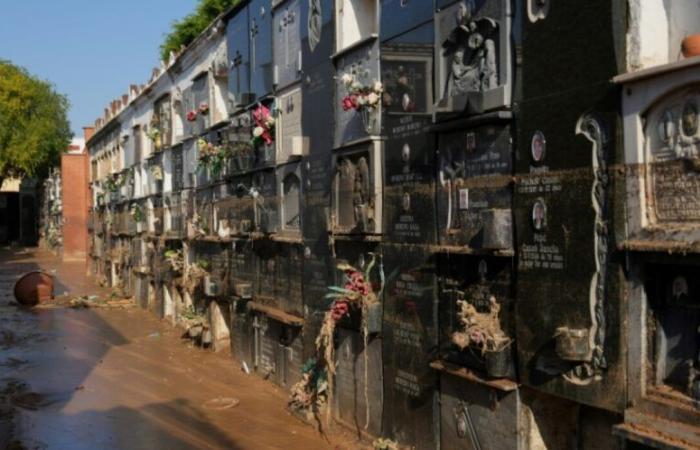The torrential rains which fell on the south-east of the country, mainly in the Valencia region, have caused at least 219 victims, and more than 80 bodies have already been handed over to families, according to judicial authorities.
But many cemeteries, such as those of Catarroja and Massanassa in the suburbs of Valencia, are still covered in mud and debris, and unable to properly accommodate the deceased. The level of destruction “is terrible,” Salvador Pons, an employee of the Catarroja municipal cemetery, told AFP, giving instructions to a group of people who volunteered to clean the site.
A man walks in the columbarium of the Massanassa cemetery, near Valencia, on November 6, 2024 – Cesar Manso – Massanassa (AFP)
Magnitude. “The water reached a height of 1.70 meters, it damaged numerous graves” but also certain niches in the columbarium, particularly those located at ground level, he adds. Proof of the extent of the flooding: the water managed to push the large 700 kilo iron gates marking the entrance to this cemetery dating from 1889 from their hinges. A challenge for the employees, who must restore the site.
Since October 29, seven residents have died in the town, three from natural causes and four from flooding. But none could be buried. And time is running out, the condition of the bodies of victims of bad weather is not good, according to Mr. Pons.
It is currently possible to carry out cremations or burials in the city of Valencia, spared from the floods. But in Spain, people generally want to bury their loved ones in vaults or in family cremation niches.
Ensemble. “My parents must be together,” said Juan Monrabal, a resident of Catarroja, to the local daily Las Provincias. It was suggested that he bury his mother, who died in the floods, in another cemetery and then move her next to his father. But the legislation does not allow this to be done before 10 years, and he, who is 54, fears he will die before then.
In its establishment in Catarroja, the funeral home Lápidas Casañ is also faced with a complicated situation. “The work has stopped, we are cleaning,” explains Arturo Casañ, 59, son of the founder. In recent days he received an order for tombstones but so far he has not been able to make them.
“I think it will be two, three or four weeks before things get better. First there are the houses, then the cemeteries,” he explains. According to the parish priest of Sant Miquel de Catarroja, Carles Pons, no funeral mass was said, more than a week after the tragedy.
Volunteers organize the distribution of emergency aid in a church in Massanassa, near Valencia, November 6, 2024 – Cesar Manso – Massanassa (AFP)
Funeral. “We were not asked to do so and, in any case, it would not be easy” to celebrate funerals as in normal times, says this 57-year-old cleric, who focuses on storing the aid that reaches the victims. For several days, funeral directors in the city of Valencia have been lending a helping hand to residents of neighboring affected communities.
“We help them with vehicles, staff, paperwork, trips to the hospital and even funerals,” says the employee of one of the funeral companies in Spain's third city, which does not does not wish to give his name. “The cemeteries of the affected localities are in a “terrible state, and people are forced to give up burying” their loved ones there, he adds.
The disaster, in fact, reduced the decision-making margins of residents. “If there is no other choice than to bury them, we will have to do it where possible,” summarizes a 69-year-old man, who came to help clean the Catarroja cemetery.
Alfons LUNA
© Agence France-Presse







